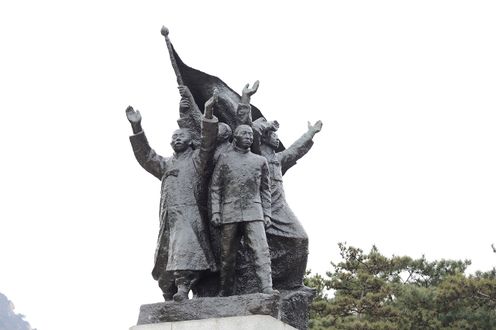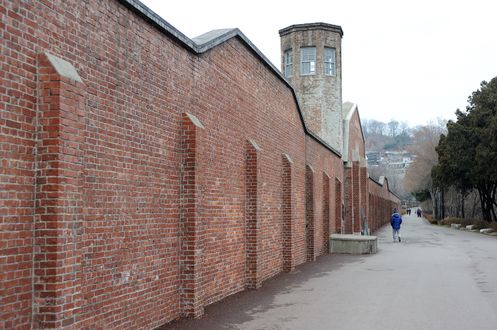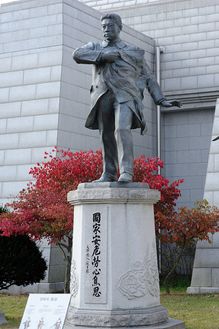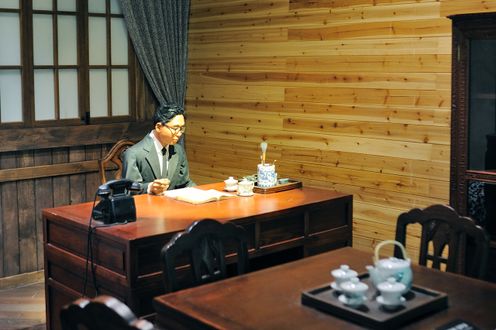"The Independence Movement and Liberation"의 두 판 사이의 차이
| (같은 사용자의 중간 판 2개는 보이지 않습니다) | |||
| 1번째 줄: | 1번째 줄: | ||
{{Kor Article| | {{Kor Article| | ||
| − | |Article= | + | |Article=독립운동과 일본으로부터의 해방 |
}} | }} | ||
| − | When Imperial Japan announced the Korea-Japan Annexation Treaty on August 29, 1910, Korea was officially colonized by Japan, and the Korean people were forced to endure its oppressive rule until August of 1945. However, numerous Korean leaders exerted strenuous efforts in and out of the country to defeat Japanese rule. Coupled with trends of world history, these endeavors resulted in the liberation of Korea on August 15, 1945. | + | When [[Japan|Imperial Japan]] announced the [[Korea-Japan Annexation Treaty]] on August 29, 1910, Korea was officially colonized by Japan, and the Korean people were forced to endure its oppressive rule until August of 1945. However, numerous Korean leaders exerted strenuous efforts in and out of the country to defeat Japanese rule. Coupled with trends of world history, these endeavors resulted in the liberation of Korea on August 15, 1945. |
| − | Diverse independence movements and armed resistance fights continued throughout Korea and abroad until achieving liberation. Korean students studying in Japan declared Korean independence on February 8, 1918 in Tokyo, and this declaration led to the | + | Diverse independence movements and armed resistance fights continued throughout Korea and abroad until achieving liberation. Korean students studying in Japan declared Korean independence on February 8, 1918 in Tokyo, and this declaration led to the [[March 1st Independence Movement]] the following year. In 1919, over 1,500 rallies and demonstrations for independence were held in Korea. Standing against ruthless Japanese suppression, armed independence groups engaged in anti-Japan armed struggles, mainly in [[Manchuria]] and [[Primorsky, Russia|Primorsky]]. |
| − | Before and after the Korea-Japan Annexation Treaty, several hundred educational organizations were established in Korea and abroad by independence activists. One of representative education activists was | + | Before and after the Korea-Japan Annexation Treaty, several hundred educational organizations were established in Korea and abroad by independence activists. One of representative education activists was [[An Chang-ho]], who pioneered education programs that inspired national consciousness and will for independence. |
| − | The Korean provisional government established in China actively carried forward anti-Japan activities. Under its strategies, Lee Bong-chang carried out a heroic deed of throwing a bomb into a parade of the Japanese Emperor in Tokyo in January 1932. Meanwhile, Yun Bong-gil seriously damaged Japanese army commander and other high-ranking officials by throwing a bomb at a war victory ceremony in Shanghai, China in April of the same year. When the Pacific War broke out in December 1941, the provisional government declared war against Japan, and planned military operations to expel Japanese troops from Korea. | + | The [[Provisional Government of the Republic of Korea|Korean provisional government]] established in China actively carried forward anti-Japan activities. Under its strategies, [[Lee Bong-chang]] carried out a heroic deed of throwing a bomb into a parade of the Japanese Emperor in Tokyo in January 1932. Meanwhile, [[Yun Bong-gil]] seriously damaged Japanese army commander and other high-ranking officials by throwing a bomb at a war victory ceremony in Shanghai, China in April of the same year. When the Pacific War broke out in December 1941, the provisional government declared war against Japan, and planned military operations to expel Japanese troops from Korea. |
| − | In the | + | In the [[Jiandao, China|Jiandao]] and [[Primorsky, Russia|Primorsky]] areas, Korean independence fighter troops actively fought against Japan. Patriots [[Kim Jwa-jin]], [[Kim Gyu-sik]], and [[Yi Beom-seok]] established the [[Northern Infantry Headquarters]] to train soldiers and stage independence activities. Among numerous battles, the one in Manchuria in October 1920 is remembered as the most victorious one when Korean troops killed over 1,200 Japanese soldiers. |
| − | Korean residents living in America also carried out independence movement led by many activists including Syngman Rhee. Rhee appealed for Korean independence at many international conferences in the US, and called for its endorsement for the Korean provisional government. Rhee was inaugurated as the first president of the Republic of Korea in 1948 when the independent Korean government was established. | + | Korean residents living in America also carried out independence movement led by many activists including [[Syngman Rhee]]. Rhee appealed for Korean independence at many international conferences in the US, and called for its endorsement for the Korean provisional government. Rhee was inaugurated as the first president of the [[Republic of Korea (South Korea)|Republic of Korea]] in 1948 when the independent Korean government was established. |
<gallery mode=packed heights=220px> | <gallery mode=packed heights=220px> | ||
| + | File:1-12.삼일운동기념비2-FSC_5807.jpg|Memorial for the March 1st Independence Movement (Jong-ro, Jongno-gu, Seoul) | ||
| + | File:1-12.삼일운동기념비5-FSC_5883.jpg|Memorial for the March 1st Independence Movement (Tapgol Park, Jong-ro, Jongno-gu, Seoul) | ||
| + | File:1-12.서대문형무소-.jpg|The old Seodaemun Prison (Independence Park, Tongil-ro, Seodaemun-du, Seoul) | ||
| + | File:1-12.서대문형무소-FSC_5857.jpg|The old Seodaemun Prison (Independence Park, Tongil-ro, Seodaemun-du, Seoul) | ||
| + | File:5-13.안중근-ESC_7667.jpg|Statue of An Jung-geun (Independence Memorial Hall, Sambang-ro, Mokcheon-eup, Dongnam-gu, Cheonan, Chungcheonnam-do) | ||
| + | File:5-14.김구-ESC_7639.jpg|Statue of Kim Gu (Independence Memorial Hall, Sambang-ro, Mokcheon-eup, Dongnam-gu, Cheonan, Chungcheonnam-do) | ||
</gallery> | </gallery> | ||
<gallery mode=packed heights=220px> | <gallery mode=packed heights=220px> | ||
| + | File:009(E).jpg|Japanese Occupation Period | ||
| + | File:031(E).jpg|Korean Provisional Goverment and Independence Armies | ||
| + | File:032-2(E).jpg|March First Movement | ||
</gallery> | </gallery> | ||
=='''Related Articles'''== | =='''Related Articles'''== | ||
| − | *[[]] | + | *[[Koreans' Resistance to Japanese Imperialism]] |
| + | *[[Shouts for Independence through Wails of Sorrow - The Japanese Occupation Period]] | ||
| + | *[[Beloved Poet and Independence Activist, Yun Dong-ju]] | ||
| + | *[[Independence Activist and Patriotic Assassin, An Jung-geun]] | ||
| + | *[[Political Leader and Independence Activist, Kim Gu]] | ||
| + | *[[Korea-Japan Annexation Treaty]] | ||
| + | *[[March 1st Independence Movement]] | ||
| + | *[[World War II]] | ||
| + | *[[Japan]] | ||
| + | *[[Manchuria]] | ||
| + | *[[Jiandao, China]] | ||
| + | *[[Primorsky, Russia]] | ||
| + | *[[Republic of Korea (South Korea)]] | ||
| + | *[[An Chang-ho]] | ||
| + | *[[Lee Bong-chang]] | ||
| + | *[[Yun Bong-gil]] | ||
| + | *[[Kim Jwa-jin]] | ||
| + | *[[Kim Gyu-sik]] | ||
| + | *[[Yi Beom-seok]] | ||
| + | *[[Syngman Rhee]] | ||
| + | *[[Provisional Government of the Republic of Korea]] | ||
| + | *[[Northern Infantry Headquarters]] | ||
=='''References'''== | =='''References'''== | ||
2017년 11월 29일 (수) 12:46 기준 최신판
When Imperial Japan announced the Korea-Japan Annexation Treaty on August 29, 1910, Korea was officially colonized by Japan, and the Korean people were forced to endure its oppressive rule until August of 1945. However, numerous Korean leaders exerted strenuous efforts in and out of the country to defeat Japanese rule. Coupled with trends of world history, these endeavors resulted in the liberation of Korea on August 15, 1945.
Diverse independence movements and armed resistance fights continued throughout Korea and abroad until achieving liberation. Korean students studying in Japan declared Korean independence on February 8, 1918 in Tokyo, and this declaration led to the March 1st Independence Movement the following year. In 1919, over 1,500 rallies and demonstrations for independence were held in Korea. Standing against ruthless Japanese suppression, armed independence groups engaged in anti-Japan armed struggles, mainly in Manchuria and Primorsky.
Before and after the Korea-Japan Annexation Treaty, several hundred educational organizations were established in Korea and abroad by independence activists. One of representative education activists was An Chang-ho, who pioneered education programs that inspired national consciousness and will for independence.
The Korean provisional government established in China actively carried forward anti-Japan activities. Under its strategies, Lee Bong-chang carried out a heroic deed of throwing a bomb into a parade of the Japanese Emperor in Tokyo in January 1932. Meanwhile, Yun Bong-gil seriously damaged Japanese army commander and other high-ranking officials by throwing a bomb at a war victory ceremony in Shanghai, China in April of the same year. When the Pacific War broke out in December 1941, the provisional government declared war against Japan, and planned military operations to expel Japanese troops from Korea.
In the Jiandao and Primorsky areas, Korean independence fighter troops actively fought against Japan. Patriots Kim Jwa-jin, Kim Gyu-sik, and Yi Beom-seok established the Northern Infantry Headquarters to train soldiers and stage independence activities. Among numerous battles, the one in Manchuria in October 1920 is remembered as the most victorious one when Korean troops killed over 1,200 Japanese soldiers.
Korean residents living in America also carried out independence movement led by many activists including Syngman Rhee. Rhee appealed for Korean independence at many international conferences in the US, and called for its endorsement for the Korean provisional government. Rhee was inaugurated as the first president of the Republic of Korea in 1948 when the independent Korean government was established.
Related Articles
- Koreans' Resistance to Japanese Imperialism
- Shouts for Independence through Wails of Sorrow - The Japanese Occupation Period
- Beloved Poet and Independence Activist, Yun Dong-ju
- Independence Activist and Patriotic Assassin, An Jung-geun
- Political Leader and Independence Activist, Kim Gu
- Korea-Japan Annexation Treaty
- March 1st Independence Movement
- World War II
- Japan
- Manchuria
- Jiandao, China
- Primorsky, Russia
- Republic of Korea (South Korea)
- An Chang-ho
- Lee Bong-chang
- Yun Bong-gil
- Kim Jwa-jin
- Kim Gyu-sik
- Yi Beom-seok
- Syngman Rhee
- Provisional Government of the Republic of Korea
- Northern Infantry Headquarters








